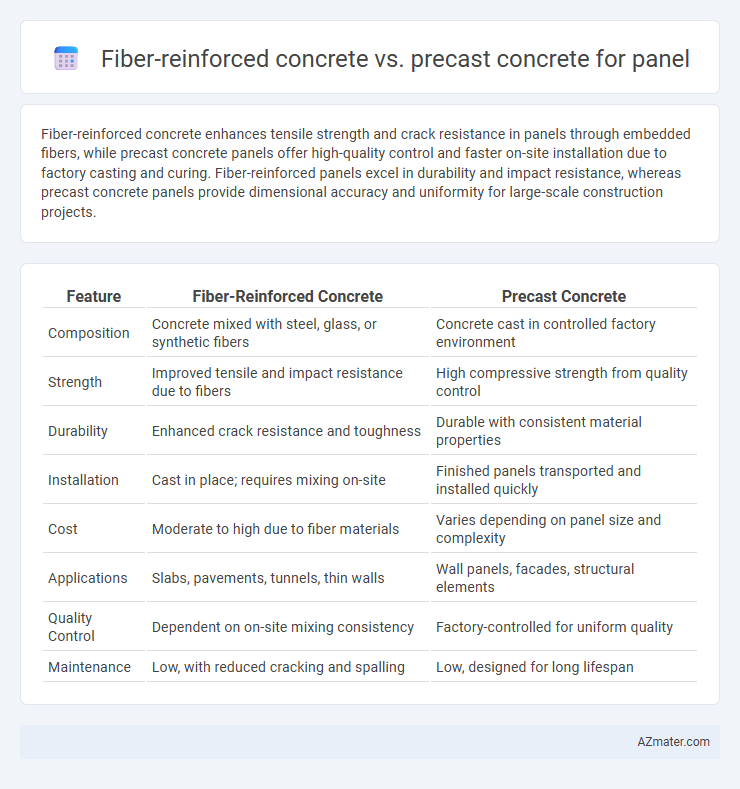Fiber-reinforced concrete enhances tensile strength and crack resistance in panels through embedded fibers, while precast concrete panels offer high-quality control and faster on-site installation due to factory casting and curing. Fiber-reinforced panels excel in durability and impact resistance, whereas precast concrete panels provide dimensional accuracy and uniformity for large-scale construction projects.
Table of Comparison
| Feature | Fiber-Reinforced Concrete | Precast Concrete |
|---|---|---|
| Composition | Concrete mixed with steel, glass, or synthetic fibers | Concrete cast in controlled factory environment |
| Strength | Improved tensile and impact resistance due to fibers | High compressive strength from quality control |
| Durability | Enhanced crack resistance and toughness | Durable with consistent material properties |
| Installation | Cast in place; requires mixing on-site | Finished panels transported and installed quickly |
| Cost | Moderate to high due to fiber materials | Varies depending on panel size and complexity |
| Applications | Slabs, pavements, tunnels, thin walls | Wall panels, facades, structural elements |
| Quality Control | Dependent on on-site mixing consistency | Factory-controlled for uniform quality |
| Maintenance | Low, with reduced cracking and spalling | Low, designed for long lifespan |
Introduction to Fiber-Reinforced Concrete and Precast Concrete Panels
Fiber-reinforced concrete panels integrate strands like steel, glass, or synthetic fibers to enhance tensile strength, crack resistance, and durability, making them ideal for applications requiring robust performance under stress. Precast concrete panels are manufactured in controlled factory environments using molds, allowing high precision, improved quality control, and faster onsite installation for structural and architectural purposes. Both materials contribute to efficient construction workflows, with fiber-reinforced concrete offering superior toughness and precast concrete panels emphasizing uniformity and expedited assembly.
Key Material Properties Compared
Fiber-reinforced concrete panels exhibit enhanced tensile strength, crack resistance, and impact durability due to the integration of steel, glass, or synthetic fibers within the matrix. Precast concrete panels provide superior uniformity, dimensional accuracy, and higher compressive strength resulting from controlled factory curing conditions. Both materials offer distinct advantages in stiffness, weight, and thermal performance, with fiber reinforcement improving flexural toughness while precast products ensure precise quality control.
Strength and Durability Performance
Fiber-reinforced concrete panels exhibit enhanced tensile strength and crack resistance due to the distribution of fibers, improving overall durability under dynamic loads and impact conditions. Precast concrete panels offer superior quality control, reduced curing time, and consistent compressive strength, contributing to excellent durability in various environmental conditions. Both materials provide robust structural performance, but fiber-reinforced concrete excels in resisting cracking, while precast concrete benefits from factory-controlled strength and uniformity.
Installation and Construction Speed
Fiber-reinforced concrete panels typically offer faster installation due to their reduced weight and enhanced tensile strength, allowing for thinner sections and easier handling on-site. Precast concrete panels, while manufactured off-site for controlled quality, require significant time for transportation and crane-assisted placement, which may slow overall construction speed. The on-site assembly of fiber-reinforced concrete panels often results in a more streamlined and efficient construction process compared to the logistical demands of precast panel installation.
Cost Efficiency and Budget Considerations
Fiber-reinforced concrete panels typically offer enhanced durability and reduced maintenance costs due to improved crack resistance, leading to long-term budget savings despite a slightly higher initial material price. Precast concrete panels provide cost efficiency through accelerated production and installation times, lowering labor expenses and site disruptions. Project-specific factors such as scale, complexity, and transportation logistics heavily influence the overall cost effectiveness between fiber-reinforced and precast concrete panel options.
Design Flexibility and Aesthetic Options
Fiber-reinforced concrete offers superior design flexibility for panels due to its enhanced tensile strength and crack resistance, allowing for thinner, more intricate shapes and curved forms. Precast concrete panels provide consistent quality and surface finishes but are generally limited to standardized molds, restricting custom aesthetic options. Architects favor fiber-reinforced concrete when unique textures, thin profiles, and complex geometries are essential for innovative panel designs.
Sustainability and Environmental Impact
Fiber-reinforced concrete significantly reduces carbon footprint by minimizing the need for steel reinforcement and enhancing durability, which extends the lifespan of panels and lowers waste generation. Precast concrete panels offer controlled manufacturing conditions that improve material efficiency and reduce on-site emissions, enabling better recycling of formwork and offcuts. Both methods contribute to sustainable construction, but fiber-reinforced concrete excels in reducing resource consumption while precast concrete optimizes production energy use and waste management.
Maintenance Requirements and Longevity
Fiber-reinforced concrete panels require less maintenance due to increased crack resistance and enhanced durability from embedded fibers, reducing the need for frequent repairs and surface treatments. Precast concrete panels offer consistent quality and controlled curing processes, resulting in superior longevity with minimal maintenance, especially when manufactured with high-grade materials and proper reinforcement. Both materials provide extended service life, but fiber-reinforced concrete excels in environments subject to dynamic loads and micro-cracking, while precast concrete is preferred for uniformity and precision in large-scale applications.
Applications in Modern Construction
Fiber-reinforced concrete enhances tensile strength and crack resistance, making it ideal for complex architectural panels and infrastructure subjected to dynamic loads. Precast concrete panels allow for rapid assembly, consistent quality control, and reduced on-site labor, suited for modular buildings and large-scale residential projects. Both materials optimize construction efficiency, with fiber-reinforced concrete favored in applications requiring durability and flexibility, while precast concrete excels in speed and repeatability.
Choosing the Right Solution for Your Project
Fiber-reinforced concrete offers enhanced crack resistance and durability, making it ideal for panels requiring flexibility and impact resistance. Precast concrete panels provide superior quality control, faster installation, and consistent dimensions, suited for large-scale projects with tight timelines. Evaluating project-specific factors such as load requirements, environmental conditions, and construction speed will guide the optimal selection between fiber-reinforced and precast concrete panels.

Infographic: Fiber-reinforced concrete vs Precast concrete for Panel
 azmater.com
azmater.com